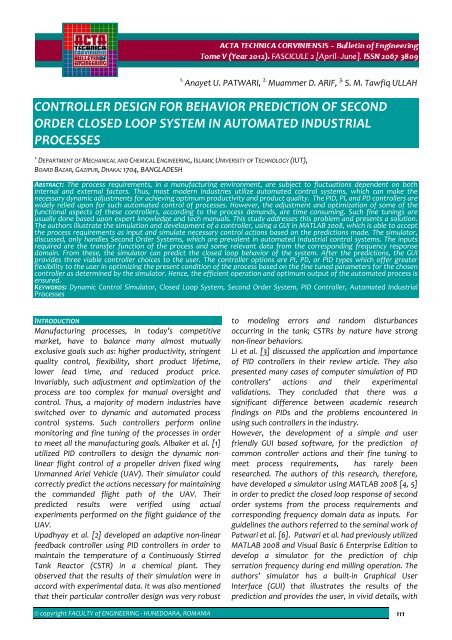Editorial & Advisory Board - Acta Technica Corviniensis
Editorial & Advisory Board - Acta Technica Corviniensis
Editorial & Advisory Board - Acta Technica Corviniensis
Create successful ePaper yourself
Turn your PDF publications into a flip-book with our unique Google optimized e-Paper software.
1.<br />
Anayet U. PATWARI, 2. Muammer D. ARIF, 3. S. M. Tawfiq ULLAH<br />
CONTROLLER DESIGN FOR BEHAVIOR PREDICTION OF SECOND<br />
ORDER CLOSED LOOP SYSTEM IN AUTOMATED INDUSTRIAL<br />
PROCESSES<br />
1.<br />
DEPARTMENT OF MECHANICAL AND CHEMICAL ENGINEERING, ISLAMIC UNIVERSITY OF TECHNOLOGY (IUT),<br />
BOARD BAZAR, GAZIPUR, DHAKA: 1704, BANGLADESH<br />
ABSTRACT: The process requirements, in a manufacturing environment, are subject to fluctuations dependent on both<br />
internal and external factors. Thus, most modern industries utilize automated control systems, which can make the<br />
necessary dynamic adjustments for achieving optimum productivity and product quality. The PID, PI, and PD controllers are<br />
widely relied upon for such automated control of processes. However, the adjustment and optimization of some of the<br />
functional aspects of these controllers, according to the process demands, are time consuming. Such fine tunings are<br />
usually done based upon expert knowledge and tech manuals. This study addresses this problem and presents a solution.<br />
The authors illustrate the simulation and development of a controller, using a GUI in MATLAB 2008, which is able to accept<br />
the process requirements as input and simulate necessary control actions based on the predictions made. The simulator,<br />
discussed, only handles Second Order Systems, which are prevalent in automated industrial control systems. The inputs<br />
required are the transfer function of the process and some relevant data from the corresponding frequency response<br />
domain. From these, the simulator can predict the closed loop behavior of the system. After the predictions, the GUI<br />
provides three viable controller choices to the user. The controller options are PI, PD, or PID types which offer greater<br />
flexibility to the user in optimizing the present condition of the process based on the fine tuned parameters for the chosen<br />
controller as determined by the simulator. Hence, the efficient operation and optimum output of the automated process is<br />
ensured.<br />
KEYWORDS: Dynamic Control Simulator, Closed Loop System, Second Order System, PID Controller, Automated Industrial<br />
Processes<br />
INTRODUCTION<br />
Manufacturing processes, in today’s competitive<br />
market, have to balance many almost mutually<br />
exclusive goals such as: higher productivity, stringent<br />
quality control, flexibility, short product lifetime,<br />
lower lead time, and reduced product price.<br />
Invariably, such adjustment and optimization of the<br />
process are too complex for manual oversight and<br />
control. Thus, a majority of modern industries have<br />
switched over to dynamic and automated process<br />
control systems. Such controllers perform online<br />
monitoring and fine tuning of the processes in order<br />
to meet all the manufacturing goals. Albaker et al. [1]<br />
utilized PID controllers to design the dynamic nonlinear<br />
flight control of a propeller driven fixed wing<br />
Unmanned Ariel Vehicle (UAV). Their simulator could<br />
correctly predict the actions necessary for maintaining<br />
the commanded flight path of the UAV. Their<br />
predicted results were verified using actual<br />
experiments performed on the flight guidance of the<br />
UAV.<br />
Upadhyay et al. [2] developed an adaptive non‐linear<br />
feedback controller using PID controllers in order to<br />
maintain the temperature of a Continuously Stirred<br />
Tank Reactor (CSTR) in a chemical plant. They<br />
observed that the results of their simulation were in<br />
accord with experimental data. It was also mentioned<br />
that their particular controller design was very robust<br />
to modeling errors and random disturbances<br />
occurring in the tank; CSTRs by nature have strong<br />
non‐linear behaviors.<br />
Li et al. [3] discussed the application and importance<br />
of PID controllers in their review article. They also<br />
presented many cases of computer simulation of PID<br />
controllers’ actions and their experimental<br />
validations. They concluded that there was a<br />
significant difference between academic research<br />
findings on PIDs and the problems encountered in<br />
using such controllers in the industry.<br />
However, the development of a simple and user<br />
friendly GUI based software, for the prediction of<br />
common controller actions and their fine tuning to<br />
meet process requirements, has rarely been<br />
researched. The authors of this research, therefore,<br />
have developed a simulator using MATLAB 2008 [4, 5]<br />
in order to predict the closed loop response of second<br />
order systems from the process requirements and<br />
corresponding frequency domain data as inputs. For<br />
guidelines the authors referred to the seminal work of<br />
Patwari et al. [6]. Patwari et al. had previously utilized<br />
MATLAB 2008 and Visual Basic 6 Enterprise Edition to<br />
develop a simulator for the prediction of chip<br />
serration frequency during end milling operation. The<br />
authors’ simulator has a built‐in Graphical User<br />
Interface (GUI) that illustrates the results of the<br />
prediction and provides the user, in vivid details, with<br />
© copyright FACULTY of ENGINEERING ‐ HUNEDOARA, ROMANIA 111

















